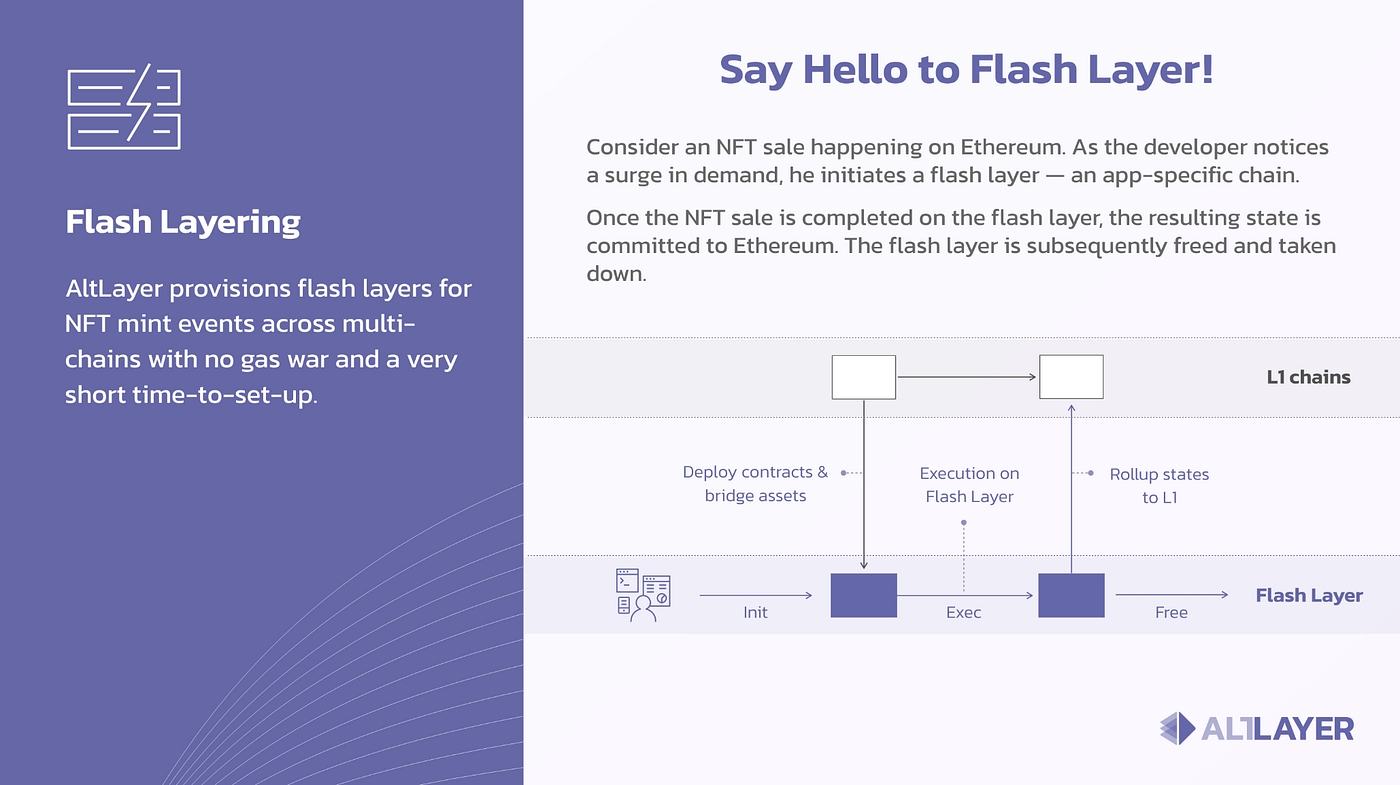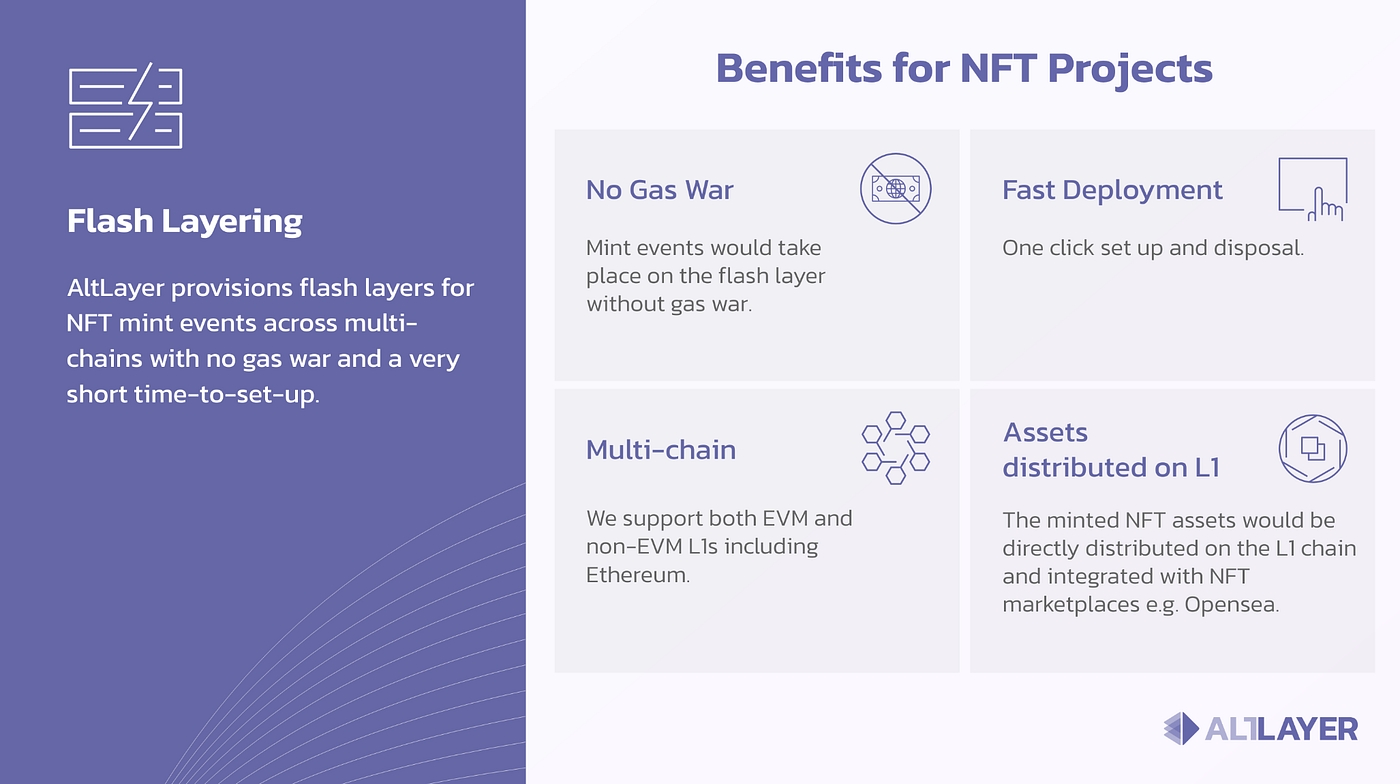NFT Mint Events
NFT mint events have a somewhat unique lifecycle compared to a fungible token. NFT minting is a short-lived event. An NFT mint event is often over in a few days (sometimes in hours or even minutes) and it’s only during that period that the user activity is extremely high. As soon as the mint event is over, the user activity slows down quite quickly to a point where the generated volume from secondary trading or other activities can be easily handled by any base-chain.
Also, the experience offered to primary and secondary buyers can be very different. Primary buyers often have to go through a whitelisting mechanism while secondary buyers can buy an NFT from a marketplace of their choice. Also, as secondary buyers are the ones driving trading volume for NFTs, it is important to ensure that a drastically different UX is not forced upon them.
Flash Layer Rollups for NFT Minting
With Flash Layer rollups, a dApp developer expecting an increase in demand for his NFT could: 1) quickly spin up a fast and scalable rollup secured by a Layer 1, 2) use the rollup for as long as needed and thereby prevent clogging of the Layer 1, and then 3) dispose of the rollup by doing an “end-of-life” settlement on the Layer 1. This makes the entire system highly resource-optimised. The execution layer and its resources are called upon only when the dApp expects a considerable demand that a Layer 1 can’t handle and once the demand tapers off, the dApp can move back to the Layer 1.

Flash Layer Rollups’s Value Proposition
Flash layer’s value proposition for NFT projects can be summarised as follows:
Mint-dedicated Scaling Layer: Flash layer allocates a mint-specific execution layer for each NFT project. As the blockspace is reserved for the project, this means that the mint event can be completely isolated from any other on-chain activity resulting in no network congestion. It will also be possible for the NFT project to make the minting process completely gasless. This feature cannot be offered on any general purpose Layer 1s, Layer 2s or EVM sidechains. In addition to the reserved blockspace for the mint event, flash layer comes with a high throughput execution environment capable of offering a dedicated 2000 TPS throughput with low block latency of 1–2s, providing a smooth experience for the mint event.
Short-lived by Design: Flash layer is tailor-made for minting as it imbibes in itself the short-lived property of mint events. A flash layer gets disposed of as soon as the mint event is over. Participants in the mint event therefore stay on the flash layer for the shortest possible time (i.e., only during minting). This is in stark contrast to application-specific NFT scaling solutions which are designed to be persistent. Users of a flash layer can continue to enjoy the base-chain user experience that they are familiar with except for a very short period of time during the entire course of the NFT’s product lifecycle. This also ensures that there is no disruption to composability with third-party dApps like NFT lending applications or games.
Automated Settlement of Assets on the Base-chain: When a flash layer set up for an NFT mint event gets disposed of, the system settles all the assets on the base-chain which basically means that all the NFTs end up on the base-chain post minting. Unlike solutions that require users to bridge assets manually, automated settlement ensures that all the NFTs get moved to the base-chain without requiring any user interference. By avoiding a manual bridging process, flash layers also entirely eliminate any bridge-associated security risks.
Unfragmented Liquidity: As all the NFTs move to the base-chain at the end of the minting process, the system guarantees unfragmented liquidity on the base-chain. This ensures that secondary market participants do not have to hop from one chain to the other to find the NFT that they wish to purchase.
Familiar UX for Mint Participants: As flash layers run the same execution engine as the base-chain, users participating in the mint event can enjoy a frictionless and familiar experience. For instance, if the base-chain is Ethereum, then users will be able to use Metamask or wallets that are EVM-compatible. They could also use familiar assets like USDC or ETH to participate in the NFT sale.
Transparent to Secondary Market Participants: Any user wishing to get involved with the NFT in the secondary market does not have to touch the flash layer. As secondary trading contributes massively to the overall NFT sales volume, this feature ensures that secondary traders do not get exposed to the flash layer at all.

In a nutshell, Flash Layer minting solution enables one click deployment, multi-chain support, unfragmented liquidity and most importantly, elimination of gas war.
Last updated